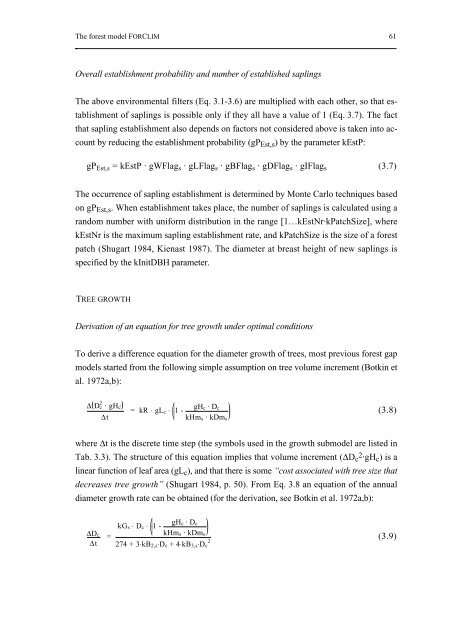On the Ecology of Mountainous Forests in a Changing Climate: A ...
On the Ecology of Mountainous Forests in a Changing Climate: A ...
On the Ecology of Mountainous Forests in a Changing Climate: A ...
You also want an ePaper? Increase the reach of your titles
YUMPU automatically turns print PDFs into web optimized ePapers that Google loves.
The forest model FORCLIM 61<br />
Overall establishment probability and number <strong>of</strong> established sapl<strong>in</strong>gs<br />
The above environmental filters (Eq. 3.1-3.6) are multiplied with each o<strong>the</strong>r, so that establishment<br />
<strong>of</strong> sapl<strong>in</strong>gs is possible only if <strong>the</strong>y all have a value <strong>of</strong> 1 (Eq. 3.7). The fact<br />
that sapl<strong>in</strong>g establishment also depends on factors not considered above is taken <strong>in</strong>to account<br />
by reduc<strong>in</strong>g <strong>the</strong> establishment probability (gP Est,s ) by <strong>the</strong> parameter kEstP:<br />
gP Est,s = kEstP · gWFlag s · gLFlag s · gBFlag s · gDFlag s · gIFlag s (3.7)<br />
The occurrence <strong>of</strong> sapl<strong>in</strong>g establishment is determ<strong>in</strong>ed by Monte Carlo techniques based<br />
on gP Est,s . When establishment takes place, <strong>the</strong> number <strong>of</strong> sapl<strong>in</strong>gs is calculated us<strong>in</strong>g a<br />
random number with uniform distribution <strong>in</strong> <strong>the</strong> range [1…kEstNr·kPatchSize], where<br />
kEstNr is <strong>the</strong> maximum sapl<strong>in</strong>g establishment rate, and kPatchSize is <strong>the</strong> size <strong>of</strong> a forest<br />
patch (Shugart 1984, Kienast 1987). The diameter at breast height <strong>of</strong> new sapl<strong>in</strong>gs is<br />
specified by <strong>the</strong> kInitDBH parameter.<br />
TREE GROWTH<br />
Derivation <strong>of</strong> an equation for tree growth under optimal conditions<br />
To derive a difference equation for <strong>the</strong> diameter growth <strong>of</strong> trees, most previous forest gap<br />
models started from <strong>the</strong> follow<strong>in</strong>g simple assumption on tree volume <strong>in</strong>crement (Botk<strong>in</strong> et<br />
al. 1972a,b):<br />
∆ D c2 · gH c<br />
∆t<br />
= kR ⋅ gL c ⋅ 1 -<br />
gH c · D c<br />
kHm s · kDm s<br />
(3.8)<br />
where ∆t is <strong>the</strong> discrete time step (<strong>the</strong> symbols used <strong>in</strong> <strong>the</strong> growth submodel are listed <strong>in</strong><br />
Tab. 3.3). The structure <strong>of</strong> this equation implies that volume <strong>in</strong>crement (∆D c2·gH c ) is a<br />
l<strong>in</strong>ear function <strong>of</strong> leaf area (gL c ), and that <strong>the</strong>re is some “cost associated with tree size that<br />
decreases tree growth” (Shugart 1984, p. 50). From Eq. 3.8 an equation <strong>of</strong> <strong>the</strong> annual<br />
diameter growth rate can be obta<strong>in</strong>ed (for <strong>the</strong> derivation, see Botk<strong>in</strong> et al. 1972a,b):<br />
∆D c<br />
∆t<br />
kG s ⋅ D c ⋅ 1 -<br />
gH c · D c<br />
=<br />
kHm s · kDm s<br />
2<br />
274 + 3⋅kB 2,s ⋅D c + 4⋅kB 3,s ⋅D c<br />
(3.9)















